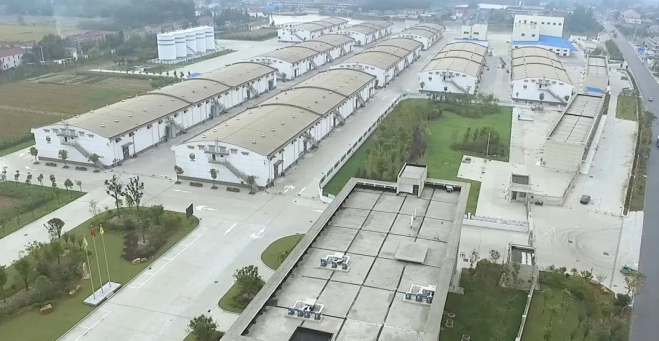I. Project Overview
Nantong Grain Group, a state-owned enterprise in Nantong City, Jiangsu Province, insists on balancing both increasing income and saving costs, as well as increasing production and reducing losses, taking multiple measures to promote grain saving and loss reduction.

Photo courtesy of Jiangsu Provincial Food and Strategic Reserves Administration
II. Program Model
1) Guiding farmers to grow good grains
Strengthening the control of grain production at the source is the first step in reducing grain loss. It has actively changed its single business model of "buying raw grain, selling raw grain". By actively connecting with farmers, promoting sustainable planting methods, optimizing planting structures, and continuously increasing the supply of high-quality grain products. Through multiple field visits, they have introduced the MAP platform, which combines variety planning, crop nutrition, crop protection, agricultural machinery services, quality orders, and smart agriculture in Nantong.
Fully utilizing advanced agricultural breeding and traceability technology, it has explored pilot cooperation with several village collectives in Nantong to establish a planting pilot area, promote the construction of good seed and good method planting bases, implement the "six-unified" model (unified land organization, technical plan, mechanical operation, financial insurance, drying and storage and brand building). In the pilot area, farmers are led to grow good quality grains and sell at good prices, achieving high-quality grain production.
2) Improving storage capacity to store good grain
Accelerating the construction of grain storage facilities. In 2023, the Nantong Municipal Government issued a three-year action plan to accelerate the construction of high-standard farmland. Nantong Grain Group has accelerated the construction of the second phase of the reserve grain company's 40,000-ton shallow circular warehouse project. In addition, it is exploring the introduction of advanced processes such as photovoltaic panels on the top of the warehouse and new radiation cooling materials to further reduce energy consumption and improve efficiency.
Upgrading and transforming finished grain low-temperature warehouses. In 2022, the finished grain low-temperature warehouse was renovated and upgraded, and a 1,150-ton finished rice reserve plan was completed, effectively improving the shortcomings of finished grain storage, such as susceptibility to moisture and heat, and further improving the quality of finished grain reserves. The group continuously optimizes post-harvest grain services. It actively provides "six services" for grain farmers, including cleaning, drying, testing, storage, processing, and sales on their behalf. During the procurement period, the procurement time, price, and drying operation arrangements are deployed in advance to ensure that the purchased grain is dried as soon as it arrives, to solve the problem of difficult drying for farmers, promote grain saving and loss reduction, and ensure that all grains are stored in the warehouse.
3) Refined management to store good grain
The group implements refined management, to reduce costs and increase benefits. Through the "loss reduction" action, it actively explores and summarizes the best ventilation timing, method, and duration for wheat and rice to reduce ventilation loss. It manages the details of warehouse entry and exit time, transportation vehicles, etc., to reduce the loss during the warehouse entry and exit process. Through the "cost reduction" action, it controls costs such as labor, electricity, medication, and maintenance, and continuously summarizes the scientific and reasonable methods of determining storage costs and cost reduction measures.
Strengthening precise control, temperature control for grain storage, and energy saving and consumption reduction. Sensors are placed in their warehouses, combined with a grain monitoring system, to collect information on grain temperature and humidity at any time. Through an intuitive 3D display, it promotes the optimization of storage measures and promotes the reduction of storage loss and quality improvement. In terms of controlling grain temperature, it connects the grain temperature measuring system with the air conditioning start control system for two-way linkage, further improving the temperature control efficiency, achieving energy saving and consumption reduction.
Emphasizing fine storage. It regards improving reserve management as an annual key task and includes it in the enterprise's annual assessment indicators. It further strengthens the airtightness of the warehouse, the ability to prevent insects in the warehouse during the summer harvest season, reduces the proportion of warehouses with secondary fumigation, and reduces the amount of medication. In terms of grain preservation technology, the group's enterprises are currently using grain cooling and mechanical ventilation technology to ensure quality, reduce losses, and promote grain storage to stay fresh.
Strengthening precise supervision to ensure that grains are always stored fresh. It insists on conducting daily supervision of finished grain and oil, spot checks the quantity and quality of finished grain and oil and improves patrol records. It regularly carries out grain and oil reserve rotation work, and includes storage quantity, quality, and rotation into assessments, compacts the main responsibility of the enterprise, and ensures that it is always stored and always fresh.
III. Lessons Learned
Grain saving and loss reduction is a systematic project, involving a long chain, a wide range, and many links. Efforts should be made to strengthen systemic thinking, comprehensive measures, explore grain "production, purchase, storage, processing, and sales" full industry chain grain saving and loss reduction.
Source: Nantong Grain and Material Reserve Bureau, Nantong Grain Group
For more information, please contact WFP China COE (wfpcn.coe@wfp.org)
Category
Various Measures to Promote Grain Saving and Loss Reduction
Contributor
Various Measures to Promote Grain Saving and Loss Reduction
Country
Case Study

